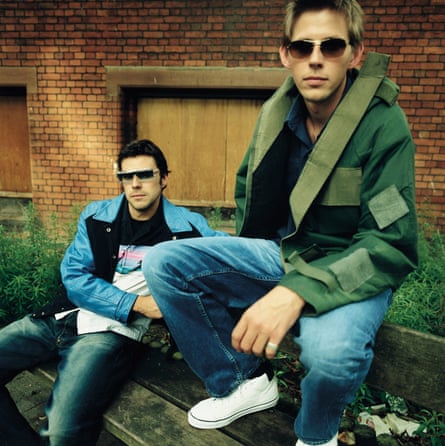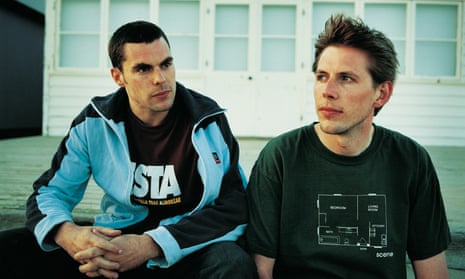Tom Findlay, songwriter, producer
A schoolfriend suggested Andy and I meet, so he came up to my attic in my parents’ house. I was lying on a beanbag and a bit stoned when he walked in, all 6ft 8 of him. The ceiling was low anyway, so I thought I was hallucinating, but we clicked. After we left university we DJ-ed together for a little club night in London, called Captain Sensual at the Helm of the Groove Armada.
When we started making music, we packed a sampler and a keyboard and rented a little old house in Ambleside in the Lake District to write an album in a week. On the last day there we picked up a Sounds of the 1950s compilation from a 50p bargain bin in the local shop. That’s where the vocal sample on At the River comes from – it’s Patti Page singing Old Cape Cod. We sampled her singing, “If you’re fond of sand dunes and salty air, quaint little villages here and there…”, slowed a breakbeat right down to get a lazy feel, and made a bass sound with the keyboard. Not using the rest of the original song’s lyrics left our song open to conjecture, giving it a slightly eerie, melancholy quality. I’d love to say it was a stroke of genius, but the truth is we could only fit 10 seconds of her singing in the sampler.
Andy and I argue to this day about who wrote the distinctive trombone riff. I think I sang it, Andy thinks he played it spontaneously, but either way we were in a room and the riff came out. We must have made the whole tune in about two hours, but then Rob da Bank made it his tune of the week in DJ Magazine and it started to take off. The initial pressing was just 500 seven-inch singles on Tummy Touch Records. As I was driving down to the record-cutting plant, a car drove into the back of me. My back wheel ended up on his bonnet. I was leaning forwards with the tape in my hand. I was in shock, but all I could think was: “We’ve got to get this to the cutting plant!”
Andy Cato, trombone, producer
It was a fluke that I had my trombone with me. I had a jazz gig coming up, so I took it up to the Lakes with me to practise. Before I saw DJ Sasha play and had an epiphany with house music, I’d been a trombonist in the Grimethorpe Colliery Band in Yorkshire. One of the miner’s cottages belonged to this bloke who was a sort of guru to all the area’s brass players. He said: “You’re not bad but you’ve got no diaphragm.” He made me lie on the floor so he could jump up and down on my stomach. You’d never get away with that now, but I did play better afterwards. My dad was a trombone player too, and the blues lick in At the River came from a spiritual we played together, also called At the River, so the title is a nod to those sessions with my dad.
The trombone melody just came to me when I was blowing over the chord sequence with the equipment set up on the dining table, before we started recording. I wanted to make a recording of it just so I could remember it, but we didn’t have a microphone. The house was in the middle of nowhere, so I made one out of the cottage’s hi-fi system, by swapping the wires around in an Alba speaker. I expected it to sound shit, but it gave the sound a real vintage character, so we put it on the record. While we were recording, news of Princess Diana’s death came on the radio. I don’t know if that added to the melancholy feel.

Rob da Bank gave our seven-inch to Zoe Ball, and she started playing it on the Radio 1 breakfast show. Then the playlist committee said it was “too slow for radio”. Luckily, various producers played it anyway, and there was such positive feedback from the listeners it ended up on the playlist. Our careers took off from there. It’s funny, when we left Ambleside, we were in two vehicles, so we made two copies of At the River “just in case” anything happened to one of us on the journey. I guess we had a feeling that it was a special tune.
Groove Armada’s 21st anniversary tour starts at the Marble Factory, Bristol, on 29 November, and continues until 2 December.

Comments (…)
Sign in or create your Guardian account to join the discussion